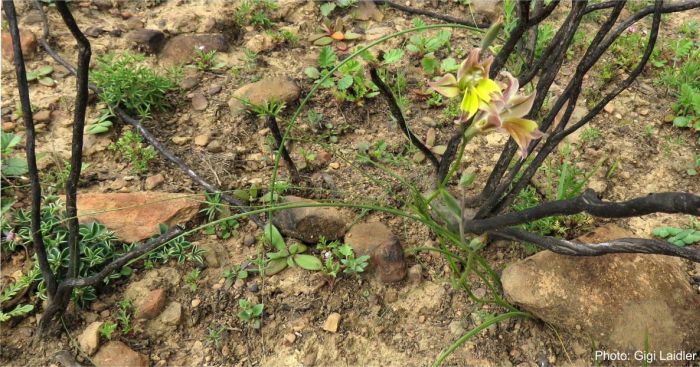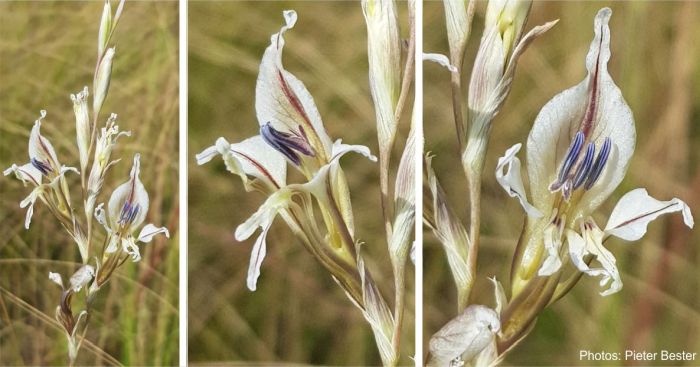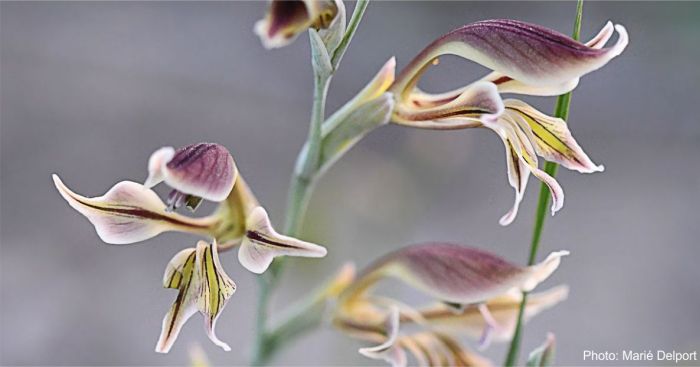Gladiolus permeabilis
Gladiolus permeabilis D.Delaroche
Family: Iridaceae
Common names: partridge pypie, small afrikander (Eng.); patrysuintjie, kleinafrikaner, koningaandblom, lituin (Afr.); khahla-e-nyenyane (Sesotho); sidvwana (siSwati)
Introduction
A hardy bulbous plant with dainty and intensely sweet-smelling flowers, perfectly paired with short grasses.

Fig. 1. Flowers of Gladiolus permeabilis var. permeabilis. (Photo: Gigi Laidler)
Description
Description
Gladiolus permeabilis is a deciduous (sheds leaves annually) geophyte (has underground bulbs, corms, rhizomes or tubers) that grows between 0.15 and 0.6 m tall. The underground parts consist of corms covered with fibrous tunics. The stem is usually erect and unbranched to 2(4)-branched. Plants have 4–7 (sometimes more) green, rigid, erect leaves. The sword-like leaves are shorter, or as long as the stem and 1–2(–3.5) mm wide, often thickened in the middle.

Fig. 2. Habit of Gladiolus permeabilis (Photo: Gigi Laidler)
Four to eight flowers are borne in an inclined and slightly flexuous spike with greyish green bracts (7–)12–18(–24) mm long. The usually sweet-smelling flowers are rather small for the genus and have tepals that narrow into long tail-like tips. A ‘window’ is visible between the dorsal and lateral upper tepals when the flower is viewed from the side. Flower colour can be variations of white, greenish cream, blueish grey, dull purple or yellowish brown with a longitudinal purplish stripe on the upper tepals and purplish streaks on the lower tepals and throat. In the winter rainfall region, G. permeabilis flowers mainly in spring, from August to October, and in summer, from October to March, in the summer rainfall region. Oval, winged seeds 4–6 × 3–4 mm are contained in ovoid-ellipsoid capsules (6–)9–16 × 5–6 mm.
Gladiolus permeabilis has two subspecies: subsp. permeabilis and subsp. edulis (Burch. ex Ker Gawl.) Oberm. Subsp. edulis differs in its long-attenuate tepals (acute or barely attenuate in subsp. permeabilis) and white, cream or grey flowers (purple, mauve or greenish brown in subsp. permeabilis). Its flowers may be sweet-smelling or not (always sweet-smelling in subsp. permeabilis).

Fig. 3. Flowers of Gladiolus permeabilis var. edulis. (Photos: Pieter Bester)
Conservation Status
Status
Both varieties of Gladiolus permeabilis are currently assessed as Least Concern (LC) and are, therefore, not threatened.
Distribution and habitat
Distribution description
Gladiolus permeabilis subsp. edulis is widespread in southern Africa and Zimbabwe, occurring in all 9 provinces of South Africa, while G. permeabilis subsp. permeabilis only occurs between Alexandria and Makhanda (formerly Grahamstown) in the Eastern Cape, and Caledon in the Western Cape. The species is usually found in stony grasslands, acacia woodlands or open, grassy shrubland where it grows on sandy or loamy soils.

Fig. 4. Typical grassy habitat of Gladiolus permeabilis. (Photo: Casper van Zyl)
Derivation of name and historical aspects
History
The genus Gladiolus is part of the Iris family (Iridaceae), which consists of about 65 genera and 1 800 species worldwide. The genus itself has about 270 species spread throughout Europe, the Middle East and sub-Saharan Africa with the majority of species (about 170) occurring in southern Africa. Gladiolus species are important horticultural plants that have been extensively hybridized and selected into many colourful varieties and cultivars. They are used as decorative garden plants and beautiful cut flowers throughout the world.
Gladiolus was named after the sword-shaped leaves; gladiolus is the diminutive of gladius, a Latin word meaning ‘sword’. The Latin name of the species refers to the characteristic ‘window’ between the upper dorsal and lateral tepals visible in side-view; permeabilis meaning ‘able to pass through’. Edulis translates to edible and refers to the edible corms of G. permeabilis subsp. edulis. Gladiolus permeabilis subsp. edulis has two synonyms, G. edulis Burch. ex Ker Gawl. and G. remotifolius Baker.

Fig. 5. Flowers of Gladiolus permeabilis showing the window between the tepals. (Photo: Marie Delport)
Ecology
Ecology
Gladiolus permeabilis has flowers that are specifically adapted for pollination by long-tongued bees. The distinctive shape and unusual colours of the flowers, along with the sweet scent lures bees such as Anthophora diversipes and Amegilla cf. fallax. The flowers also contain some sweet nectar.
The corms are eaten by wild birds such as partridges, francolin and spurfowl.
The winged seeds are dispersed by wind.

Fig. 6. Capsules and seeds of Gladiolus permeabilis. (Photos: Kevin Koen and Pieter Bester)
Uses
Use
While Gladiolus permeabilis is not yet widely used in horticulture, other species of the genus have been cultivated as ornamental plants and for cut flowers. These species include G. cardinalis, G. carneus, G. cruentus, G. dalenii, G. oppositiflorus, G. papilio and G. tristis. Other wild species perfect for domestic use are G. dalenii and G. saundersii, amongst others.
As the name indicates, G. permeabilis subsp. edulis also seems to have some value as a food plant. The local people of Litakun, a village between Kuruman (Northern Cape) and Vryburg (North West), prepare the corms of this taxon by lightly roasting them before eating them. The taste is said to be similar to that of chestnuts, rather sweet. It is known locally in this area as litúin or litúing.
Growing Gladiolus permeabilis
Grow
Gladiolus permeabilis plants are summer flowering, relatively easy to grow and quite hardy. Although they occur naturally throughout most of South Africa (except for the dry Northern Cape interior), plant them in a sunny but sheltered spot for optimal growth. Plants might flower in semi-shade, but flowering might be impacted in full shade. Flower spikes might bend or break in windy or exposed areas. These dainty plants are perfect for small gardens or garden beds and pair well with smaller grasses. Plant many plants together to ensure a beautiful and sweet-scented display when in flower. They usually grow in late winter and spring, flower from late winter to early autumn (August-March) and are dormant during the winter.
Propagate Gladiolus permeabilis plants from corms or seeds. In the winter rainfall region, plant the corms or sow the seeds in autumn and in the summer rainfall region in winter or early spring. When propagating from seeds, sow the seeds freely and replant the corms when they form. When propagating from corms, the fibrous tunics covering the corm should only be removed just before planting as they may offer some protection against infections and infestations. After removing the tunics, treat the corms with fungicide. Place the corms about 5 cm deep in the soil with the point facing up, about 10 cm apart or as desired (depending on the garden layout). Plants planted together will produce a more prominent flowering display. Every year after the leaves appear, the corm dies, and a new corm develops. After the plants die, remove the corms from the soil and store in a cool dry place until the next season.
Plant Gladiolus permeabilis in sandy loam soil, with good drainage. Soggy compacted soil hinders root growth and may contribute to root rot. Many soils can be adapted for Gladiolus permeabilis by adding organic matter such as compost, leaves, manure or even hay to the soil six months before planting. The soil should be neutral or slightly acidic with an ideal pH of 6–6.5. Water soil thoroughly after planting. Water plants in the summer rainfall region by drenching them regularly, those in the winter rainfall region less often. Adjust the watering regime according to the local conditions. Plants need a lot of water during the growing season, particularly when in bud and flower, but never let the soil become waterlogged. Water on the ground or at the base of the plant, not on the leaves, to avoid pest infestations. Top dress with rich compost when the new growth appears or give a fortnightly feed of high potassium fertilizer such as 3:1:5 or 2:3:4.
Possible pests of Gladiolus plants include various root rots (e.g. Fusarium oxysporum, Septoria gladioli, Stromantina gladioli), storage rots (Penicillium sp., Botrytis gladiolorum), viruses (Rhizopus arrhizus, mosaic viruses) and bacterial blight (Xanthomonas campestris), as well as aphids, slugs and snails. For more on the treatment of Gladiolus pests and diseases see the planting instructions by Bot Flowerbulbs listed under References.
References
- Bot Flowerbulbs, Gladiool Teeltinformatie. Online. https://botflowerbulbs.nl/wp-content/uploads/2017/05/Plant_instr_Gladiool.pdf.
- Burchell, W.J. 1953 (reprint of the original 1822-4 edition). Travels in the interior of southern Africa. Volume 2. The Batchworth Press, London.
- Duncan, G. 2010. Grow bulbs. A guide to the cultivation of bulbs of South Africa and neighboring countries. Kirstenbosch Gardening Series. South African National Biodiversity Institute, Cape Town.
- Goldblatt, P. & Manning, J. 1998. Gladiolus in southern Africa. Fernwood Press, Cape Town.
- Goldblatt, P. & Manning, J.C. 2020. Iridaceae of southern Africa. Strelitzia 42. South African National Biodiversity Institute, Pretoria.
- iNaturalist. Observations of Gladiolus permeabilis. https://www.inaturalist.org/observations?place_id=any&taxon_id=531573.
- Raimondo, D., Von Staden, L., Foden, W., Victor, J.E., Helme, N.A., Turner, R.C., Kamundi, D.A. & Manyama, P.A. (eds) 2009. Red list of South African plants. Strelitzia 25. South African National Biodiversity Institute, Pretoria.
- Smith, C.A. 1966. Common names of South African plants. Memoirs of the Botanical Survey of South Africa No. 35. Government Printer, Pretoria.
- Watt, J.M. & Breyer-Brandwijk, M.G. 1962. The medicinal and poisonous plants of southern and eastern Africa , edn 2. Livingstone, Edinburgh & London.
Credits
Natasha Lombard
National Herbarium, Pretoria
February 2022
Acknowledgements: the author thanks Casper van Zyl, Gigi Laidler, Kevin Koen, Marié Delport and Pieter Bester for providing images of Gladiolus permeabilis (via iNaturalist).
Plant Attributes:
Plant Type: Bulb
SA Distribution: Eastern Cape, Free State, Gauteng, KwaZulu-Natal, Limpopo, Mpumalanga, North West, Northern Cape, Western Cape
Soil type: Sandy, Loam
Flowering season:
PH: Acid, Neutral
Flower colour: Brown, Green, Purple, White, Cream, Yellow, Mauve/Lilac
Aspect: Full Sun, Morning Sun (Semi Shade), Afternoon Sun (Semi Shade)
Gardening skill: Easy
Special Features:
Horticultural zones











Rate this article
Article well written and informative
Rate this plant
Is this an interesting plant?
Login to add your Comment
Back to topNot registered yet? Click here to register.